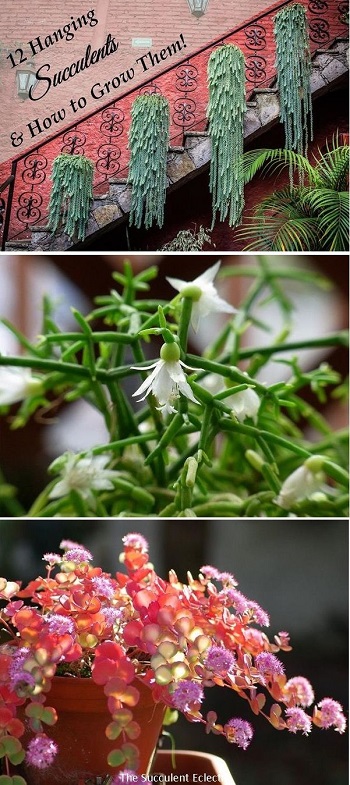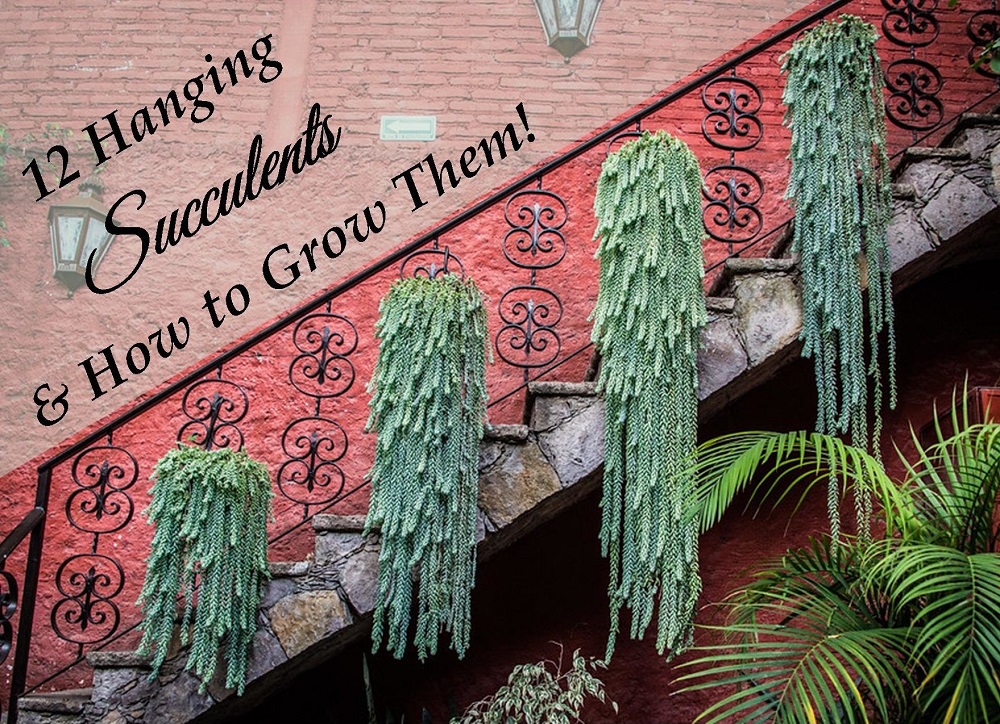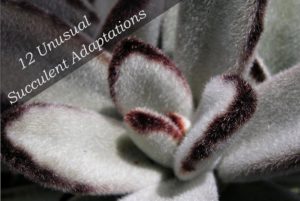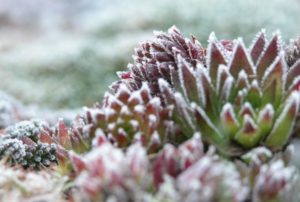Have you ever said, “I love hanging succulents — but mine always die.” Do you envy the lush, long growth you see on Instagram and Facebook posts yet despair of ever seeing it in your own garden? You’re not alone! There is a reason your hanging cactus or succulent struggles — especially when it’s your favorite plant. Today, we’re going to change all that. Together, let’s take a close look at 12 sensational trailing succulents and exactly how to care for each one. This is not an exhaustive list. Some are familiar favorites, others you may have never “met”. Each variety is easy to source AND easy to grow — even if you’ve been killing them all your life!
{Please note, some links in this post may be affiliate links to sites that pay me a small commission if you click on the link and make a purchase. This commission is at absolutely no cost to you. I only recommend products and companies that I have worked with and truly love! ~Kat}
Hanging Succulents
In this Post We'll Cover:
- Hanging Succulents
- What are Hanging Succulents?
- Sedum Moriganianum — Donkey’s Tail
- Portulacaria afra variegata — Trailing Rainbow Bush
- Rhipsalis neves-armondii — Rice Cactus
- Hoya carnosa — Indian Rope Plant
- Senecio radicans — String of Bananas
- Disocactus flagelliformis — Rat Tail Cactus
- Sedum sieboldii variegata — Colorful Foliage
- Senecio jacobsenii — Trailing Jade
- Sedum Clavatum — Trailing Sedum Rosettes
- Graptopetalum paraguayense — Trailing Ghost Plant
- Crassula pellucida variegata — Calico Kitten
- Senecio rowleyanus — String of Pearls
- Hanging Cactus and Hanging Succulents
- What are Hanging Succulents?
This is a loooong post packed with information. Read through, or jump ahead to your point of interest:
- What are Hanging Succulents?
- Sedum Moriganianum — Donkey’s Tail
- Portulacaria afra variegata — Trailing Rainbow Bush
- Rhipsalis cereuscula — Rice Cactus
- Hoya carnosa — Indian Rope Plant
- Senecio radicans — String of Bananas
- Disocactus flagelliformis — Rat Tail Cactus
- Sedum sieboldii variegata — Colorful Foliage
- Senecio jacobsenii — Trailing Jade
- Sedum Clavatum — Trailing Sedum Rosettes
- Graptopetalum paraguayense — Trailing Ghost Plant
- Crassula pellucida variegata — Calico Kitten
- Senecio rowleyanus — String of Pearls
What are Hanging Succulents?
Trailing or hanging succulents have a dramatic appeal, don’t they? They defy expectations. We expect plants to grow upward, toward the sun. It’s intriguing to see lush, healthy plants that grow out and down, rather than up. This unusual growth habit typically does not translate to special needs. Just as with any succulent, the better you understand the plant and meets its basic needs, the happier and healthier it will be.
Trailing or hanging cactus and succulents have stems that do not support the full weight of the plant in upright growth. These pendulous stems do not permit the plant to compete well among its neighbors for available sunlight. This is why most trailing succulents cannot tolerate full, direct sun all day. (Take note!) But there are two notable evolutionary advantages for trailing plants. They spend no resources developing stiff, rigid plant matter for their stems, enabling the plants to invest in greater root and leaf development. A trailing habit also allows hanging succulents to crowd out their neighbors, smothering nearby plants with their own growth. This cuts down on competition for that most precious of natural resources where succulents grow — water.
Let’s take a closer look at 12 stellar hanging succulents and hanging cactus(!) you can find and grow as a part of your succulent collection.
Sedum Moriganianum — Donkey’s Tail
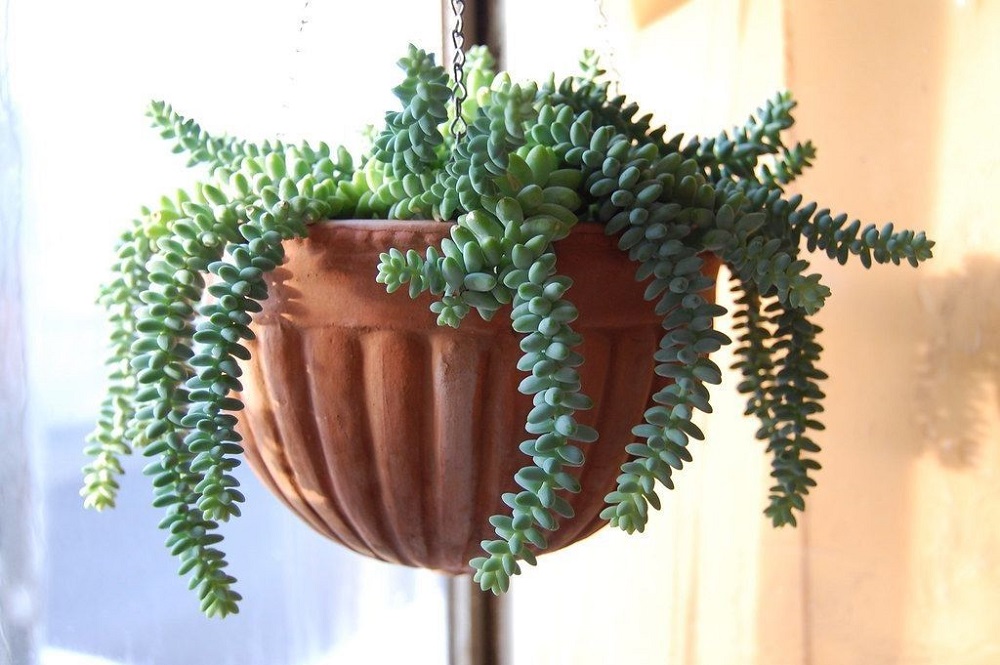
Sedum morganianum, commonly known as donkey’s tail or burro’s tail sedum, is a fast-growing succulent that cascades over the edge of any container. Thick, plump leaves form overlapping on thick stems that can reach 4 feet long. For a more compact version, check out the dwarf version, Sedum Burrito.
The challenge with this hanging succulent is that the leaves pop off fairly easily. This is an adaptation, enabling the plant to respond to rough handling by passing herbivores, heavy weather or gardeners with a chance for propagation. Sedum morganianum roots easily from cuttings or individual leaves. Handle the plant gently to keep the leaves intact.
This trailing succulent is easy to please. Provide plenty of bright light to keep your burro’s tail lush and full. Water only when the soil is dry. Sedum Morganianum is hardy to zone 10, (30 °F / -1 °C).
Portulacaria afra variegata — Trailing Rainbow Bush
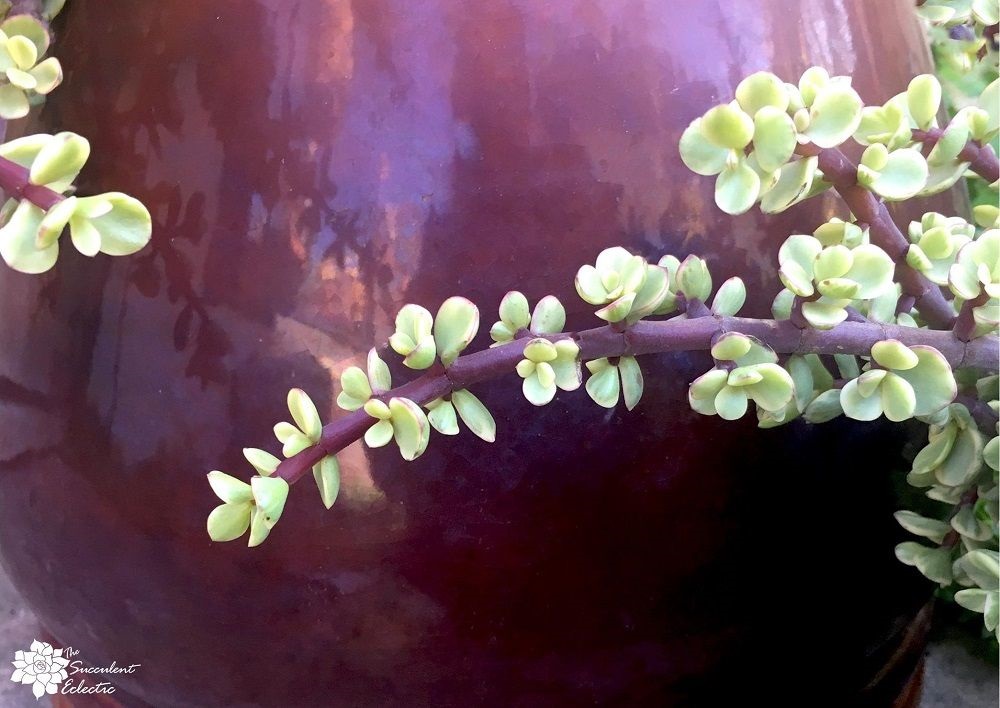
Portulacaria afra variegata is a trailing and variegated form of the popular elephant’s food plant, commonly called rainbow bush. Rich, burgundy stems arch out and down, producing pale green leaves with ivory margins.
Train your portulacaria to hang down more dramatically with selective pruning. Make a cut just past a leaf node on the underside of a stem. As the plant grows, it will form a downward-facing branch from that node.
Rainbow bush is tolerant of a wide range of sun exposure. Provide bright light for several hours a day for the best coloring. Plant in fast-draining succulent soil and water only when the soil is dry. Hardy in zone 10, (30 °F / -1 °C).
Rhipsalis neves-armondii — Rice Cactus
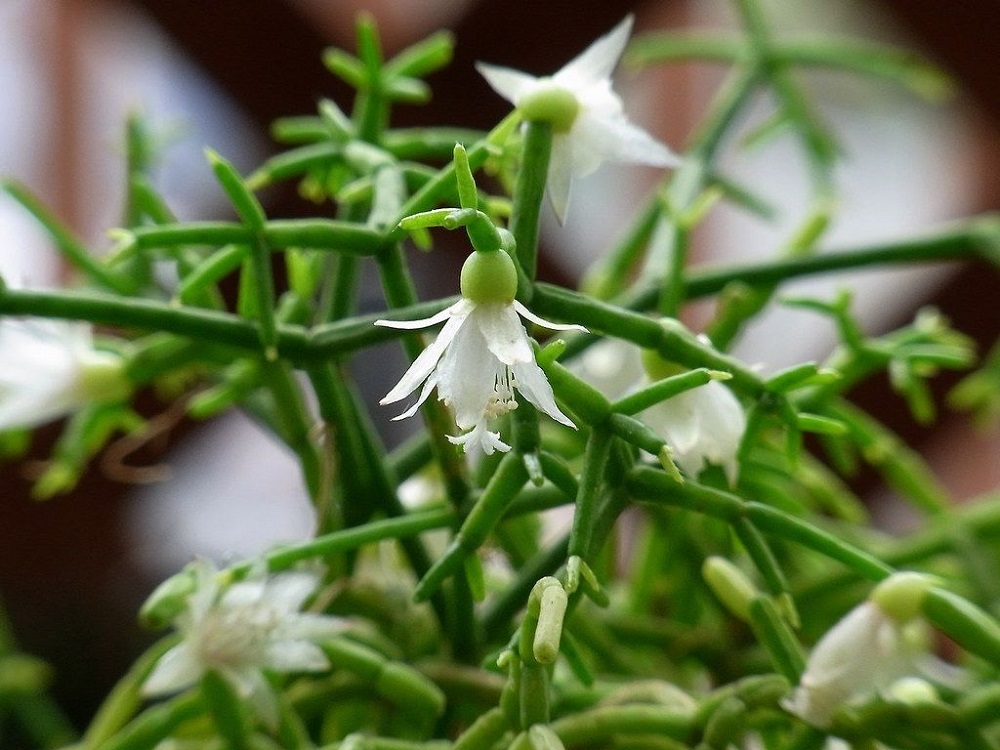
Rhipsalis neves-armondii is actually a hanging cactus. It’s a fascinating, spineless cactus formed by branching stems with short, rice-like joints. It is a tropical epiphyte(Eh-PIH-fite) A plant that grows on another plant (typically… More, meaning it grows in trees, gathering moisture and nutrients from the surrounding air. Epiphytes(Eh-PIH-fites) A plant that grows on another plant (typicall… More are not parasites and do not damage the trees they live on. While small, Rhipsalis neves-armondii grows upright, but at the 6-inch mark, the stems become pendant and form graceful, arching sprays, forming an airy plant. Cheery, white, bell-shaped blooms form in spring when the plant is given ample light. The blooms seem to glow in moonlight and are followed by small, white berries.
Rhipsalis cereuscula is a hanging cactus that evolved growing on large trees under the leafy canopy of a rain forest. Try to mimic these conditions in terms of light, soil and humidity. It needs abundant light to thrive, yet burns in direct sun during mid-day. Provide morning sun and bright, filtered shade throughout the day. It can be grown indoors, away from hot mid-day sun through the windows. Consider supplementing ambient light with a grow light.
Like all succulents, Rhipsalis need fast-draining succulent soil. Add more organic matter like coco coir or an orchid mix to your soil mix and your rice cactus will thrive. Only water when the soil is nearly dry. Supplement the water in the soil with occasional misting, but ensure good airflow around the plant. Hardy in zone 10, (30 °F / -1 °C).
Hoya carnosa — Indian Rope Plant
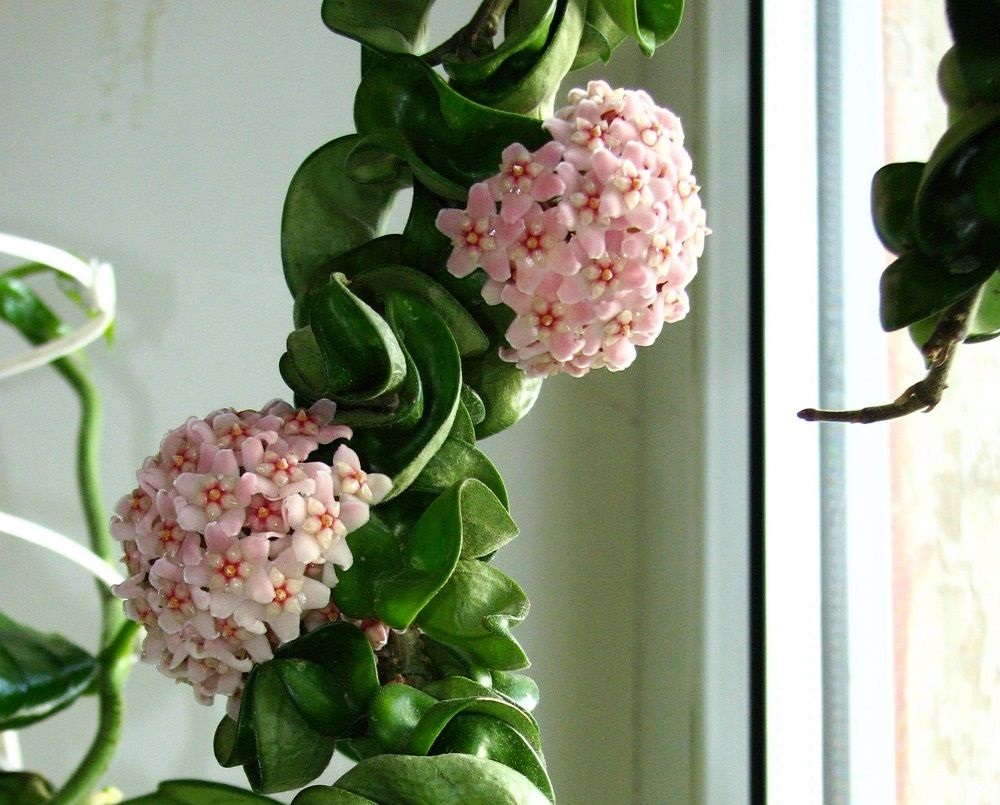
Hoya carnosa, aka Indian rope plant or the wax plant, has broad, waxy-looking leaves that curl and twirl around the central stem. Unlike some trailing succulents, the stems of hoya hang straight down and can reach 10 feet long. Mature plants develop clusters of white to pink blooms with an intoxicating scent. For best blooms, provide ample light and keep the roots fairly pot-bound.
Hoyas thrive in soil made from 2 parts sphagnum peat moss to 1 part pumice. From spring through fall, these plants go through a fair amount of water. Water thoroughly, then allow the soil to dry well till just damp between waterings.
Provide bright, indirect light for your rope plant, and always protect it from cold temps. Hoya will tolerate temps down to 50°F (10°C) but should not be allowed to get colder. Wax plants will grow happily indoors year-round or move them indoors over the winter.
Senecio radicans — String of Bananas
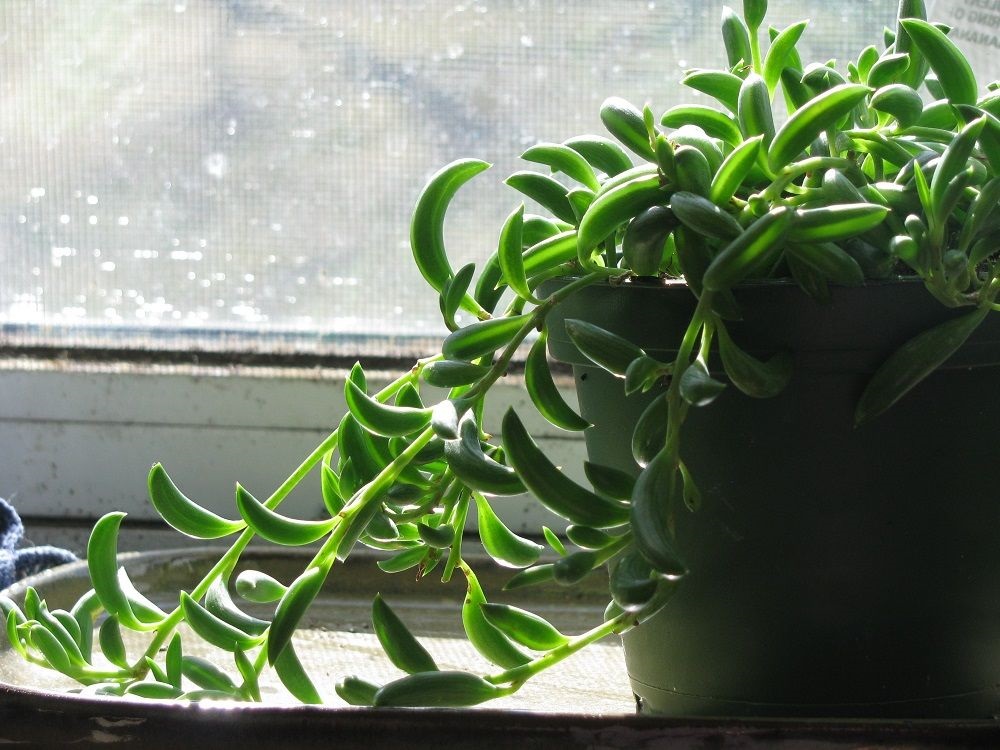
Senecio radicans, string of bananas, is a popular hanging succulent that cascades over the side of any planter. It is closely related to the string of pearls you may love to hate. But “bananas” is easier to grow. The stems are thicker, and the plant is far less touchy than string of pearls.
String of bananas is charming in its own right. The stems reach 6 feet long. Pinch stems back to make them branch, for fuller, lusher growth. Plant in good succulent soil. Water thoroughly, allowing the soil to dry well between waterings. Provide plenty of bright light, though not direct sun, and Senecio radicans will thrive for you.
Senecio radicans is closely related to the whimsical and rare Senecio peregrinus String of dolphins. Hardy in zone 10, (30 °F / -1 °C).
Disocactus flagelliformis — Rat Tail Cactus
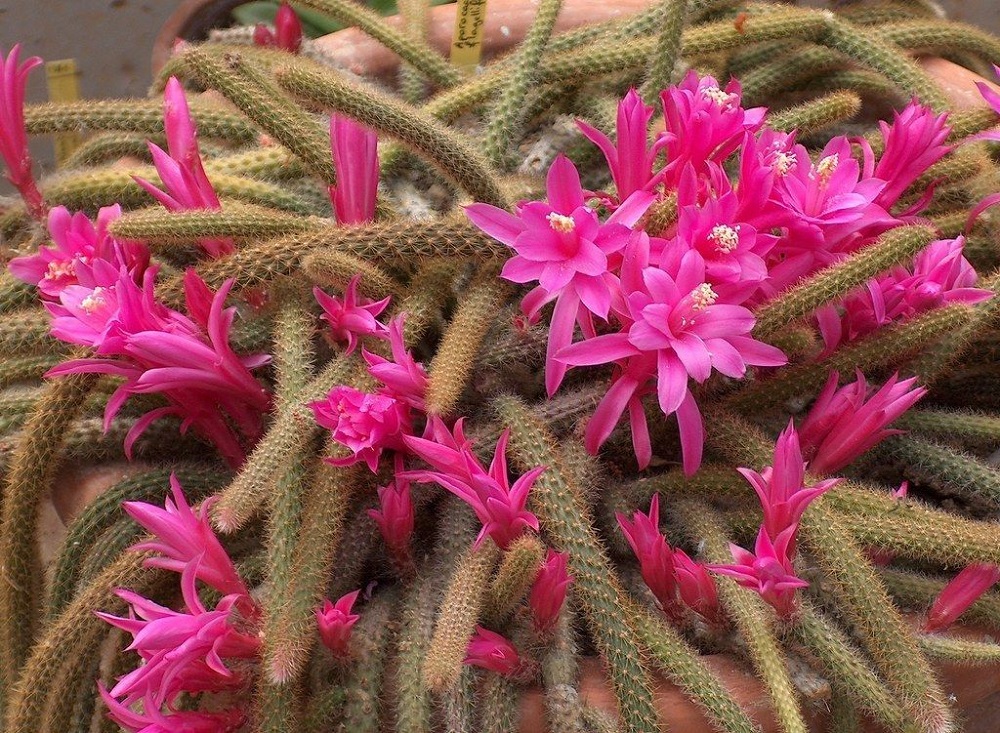
Disocactus flagelliformis, or the rat tail cactus, is a striking hanging cactus. Like the Rhipsalis cereuscula, above, the rat tail cactus is an epiphyte, growing in trees in its native habitat. However, this cactus has plenty of short, fine, fuzzy-looking spines.
Disocactus produce dazzling blooms and are widely grown as ornamental plants. This is an excellent choice for a hanging basket. Plant in fast-draining succulent soil. Re-pot in fresh soil every other year, without going to a larger pot unless it seems too crowded.
Young rat tail cactus stems start upright, soon to arch, then hang straight down. For the best blooming, provide this hanging cactus bright, indirect light. Protect from temps below 43 °F (6.1 °C). With ample light, rat tail cactus grow well indoors.
Sedum sieboldii variegata — Colorful Foliage
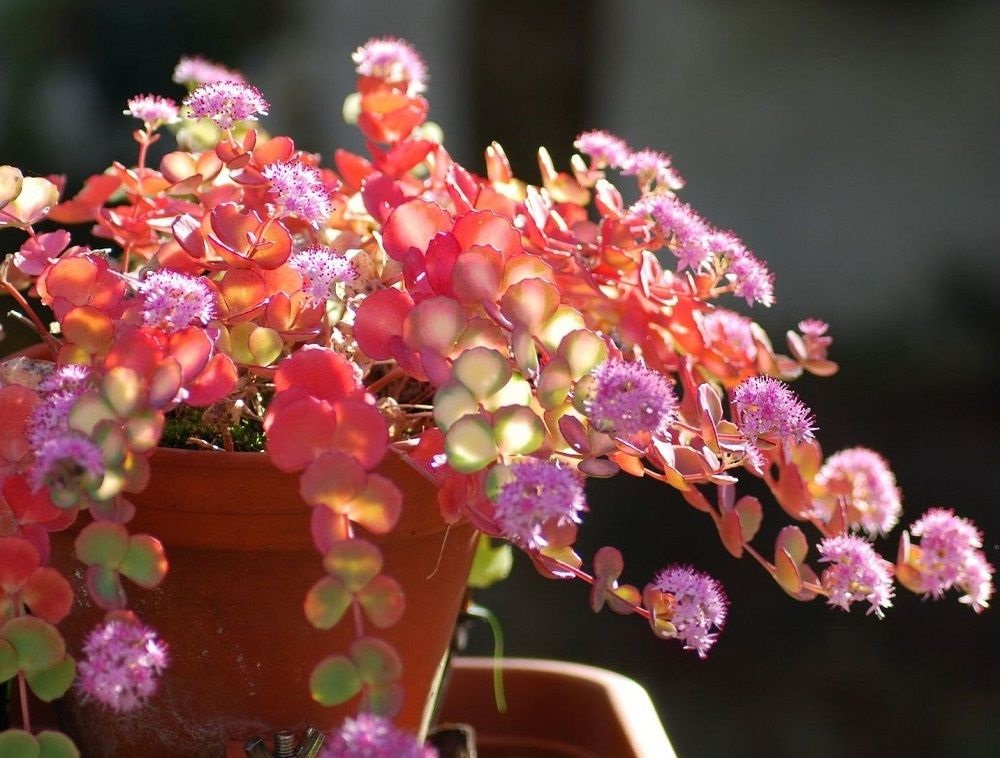
Sedum sieboldii variegata has been re-classified as Hylotelephium sieboldii. This is a lovely, variegated form of a mounding, trailing succulent. Half-inch round, blue-green leaves have a creamy yellow center. During hot summer months, the scalloped margins of sieboldii’s leaves may flush bright pink. Abundant lilac blooms form in fall and are a favorite for butterflies and bees.
Non-variegated Sedum sieboldii is commonly called October Daphne. If solid-color leaves form on the variegated succulent, pluck the leaves off, to encourage more variegated growth.
Plant sedum sieboldii variegata in fast-draining succulent soil and water only when the soil is dry. This beauty is cold hardy to zone 6, (-10 °F / -23 °C).
Senecio jacobsenii — Trailing Jade
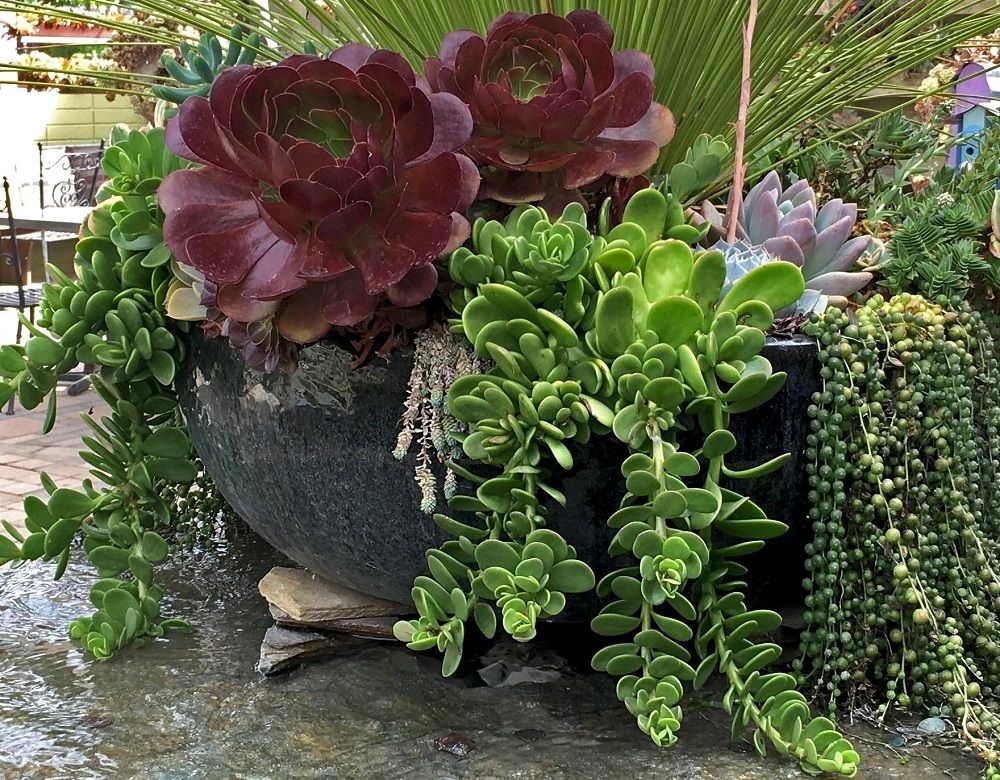
The large, round leaves of Senecio jacobsenii, or trailing jade, flush pink when grown in full sun or when temps dip below 45 °F (-7.2 °C). The thick stems of this hanging succulent trail to 4 feet long.
Trailing jade is shy to bloom. Plant in fast-draining succulent soil. Water thoroughly and allow the soil to fully dry before watering again. Stems branch when cut to make a fuller plant. Be sure to root cuttings to propagate and start more trailing jades.
Senecio jacobsenii is exceptionally easy to grow. Happy in lighting ranging from direct sun to shade outdoors or lots of bright light indoors. Hardy to zone 10, (30 °F / -1 °C).
Sedum Clavatum — Trailing Sedum Rosettes
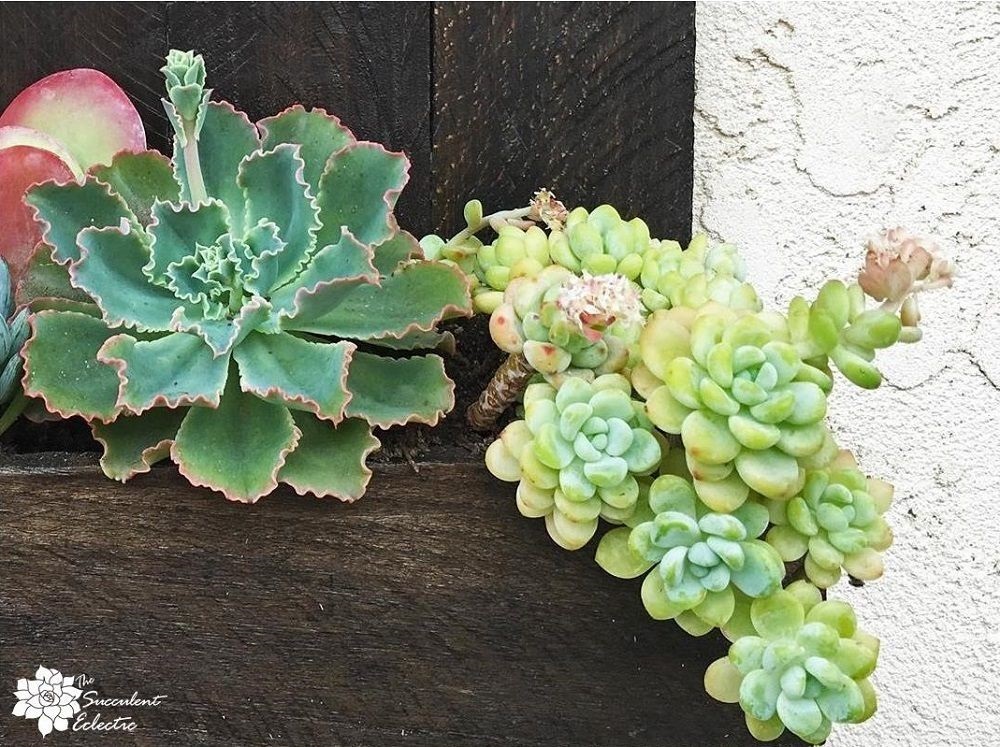
Sedum clavatum is one of my all-time favorite plants to grow. Chubby, blue-green rosettes form on fat stems to tumble over the side of a planter and will reach nearly 1 foot long. Clusters of pale pink blooms flower freely in the spring — a favorite of butterflies.
Plant Sedum clavatum in fast-draining succulent soil and water well. Allow the soil to fully dry between waterings.
Happy in a range of lighting from full sun (with blue rosettes) to shade outdoors. Indoors, grow in plenty of bright, indirect light. Hardy to zone 10, (30 °F / -1 °C).
Graptopetalum paraguayense — Trailing Ghost Plant
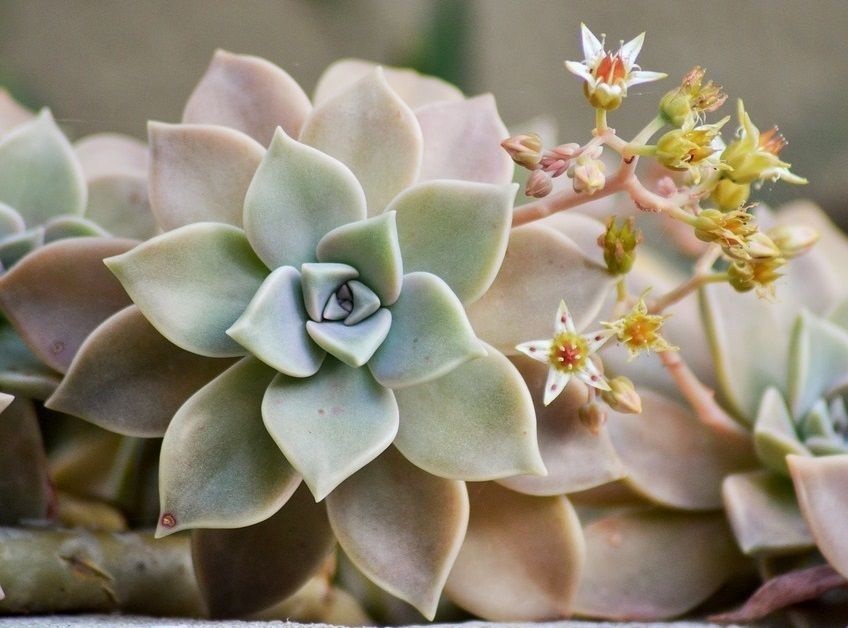
Graptopetalum paraguayense is commonly called the ghost plant. Large, opalescent rosettes form at the ends of long, curling, pendant stems. The coloring on the ghost plant is highly variable. Nearly white rosettes can blush pink, yellow or blue on this incredible hanging succulent.
Best in a large container, each rosette can reach a full 6 inches across. Rather than hanging straight down, the stems arch and curl in a somewhat untidy sprawl. The plant produces sprays of starry blooms in the spring. Plant Graptopetalum paraguayense in fast-draining succulent soil. Water thoroughly and allow to dry between waterings.
The ghost plant does best with loads of light. While it can be overwintered indoors over the winter, the plant is happiest in partial to full sun. With abundant light, this trailing succulent is not just easy to grow, but hard to kill! Hardy to zone 9, (20 °F / -6.6 °C)
Crassula pellucida variegata — Calico Kitten
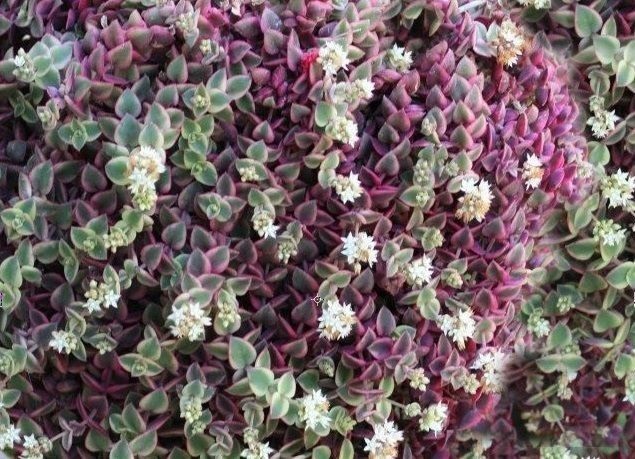
Crassula pellucida variegata forms a bouquet of burgundy stems topped by tiny pink-edged green and white valentine hearts that spill and trail over the edge of a container. Commonly called calico kitten, this colorful, trailing succulent has a fine texture perfect for contrasting with large, rosette forms like Echeveria and Graptoveria.
Plant Crassula pellucida in fast-draining succulent soil. Water thoroughly, allowing the soil to dry well between waterings. Easy to grow, this hanging succulent is also easy to propagate.
Calico kitten thrives in filtered light to partial sun outdoors. Indoors, provide plenty of bright, indirect light. Hardy to zone 10, (30 °F / -1 °C).
Senecio rowleyanus — String of Pearls
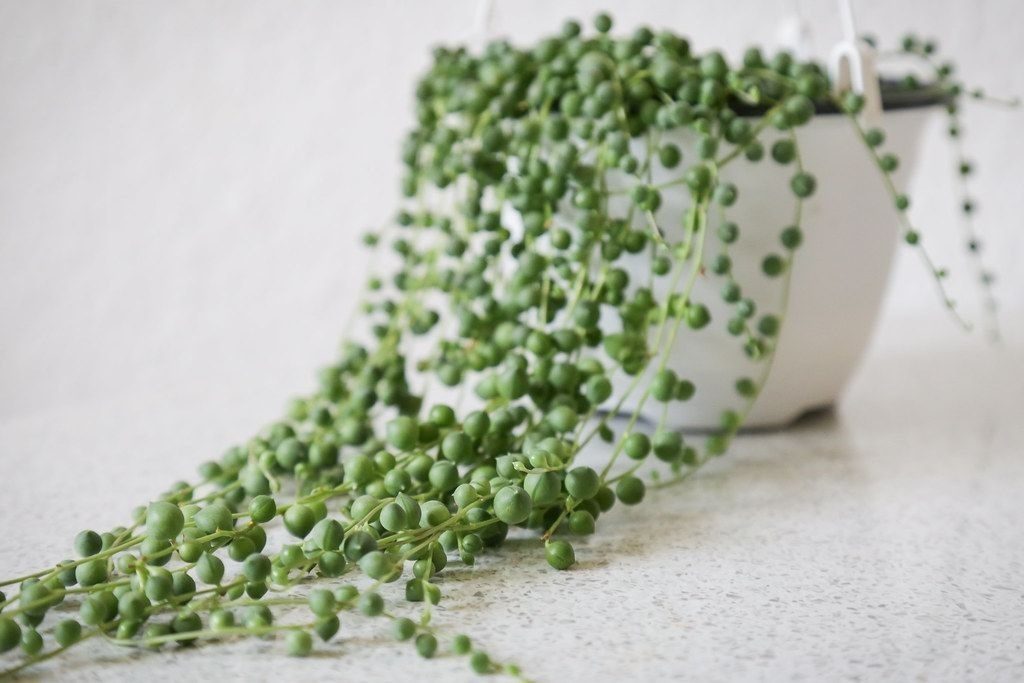
And finally — Senecio rowleyanus – String of pearls. So many succulent addicts enthusiasts have a love/hate relationship with this exquisite plant. We all love looking at it, but many find it frustrating to grow. Many tell me that no matter how much they baby this plant, they always wind up killing it. Regular readers will know my answer — stop! Stop giving your favorite succulents different care from the rest. Succulents thrive on benign neglect, even those you love. Specifically, string of pearls needs bright light, but may sunburn if in full sun all day. Mine grow best with ample morning light and light shade through the afternoon. This is a great plant to protect with shade cloth if your garden is flooded with sunshine. It can also grow well indoors if you can provide excellent air circulation and plenty of bright light.
Don’t mist your string of pearls — that will risk rot. Instead, water thoroughly until water runs from the drainage holes. Water only when the soil is dry. Those round pearls can act as a water gauge. When they are plump and round, the plant does not need water. When the pearls develop a point and are no longer round, the plant is drawing down it’s stored moisture, and it’s time to water. I often plant Senecio rawleyanus in a mixed succulent planting. I always watch the pearls to let me know when the planter needs water. Not only do I not baby it, I use it’s stress level indications to tell me how to care for other succulents.
Sencio rowleyanus string of pearls is easy to grow once you stop babying it. Clip back any stems with few pearls so the plant will grow fuller. Root your pearls cuttings in dry soil — just cover 1-2 inches of bare stem and 2+ nodes. Plant in fast-draining succulent soil. Hardy to zone 10 (30 °F / -1 °C).
Hanging Cactus and Hanging Succulents
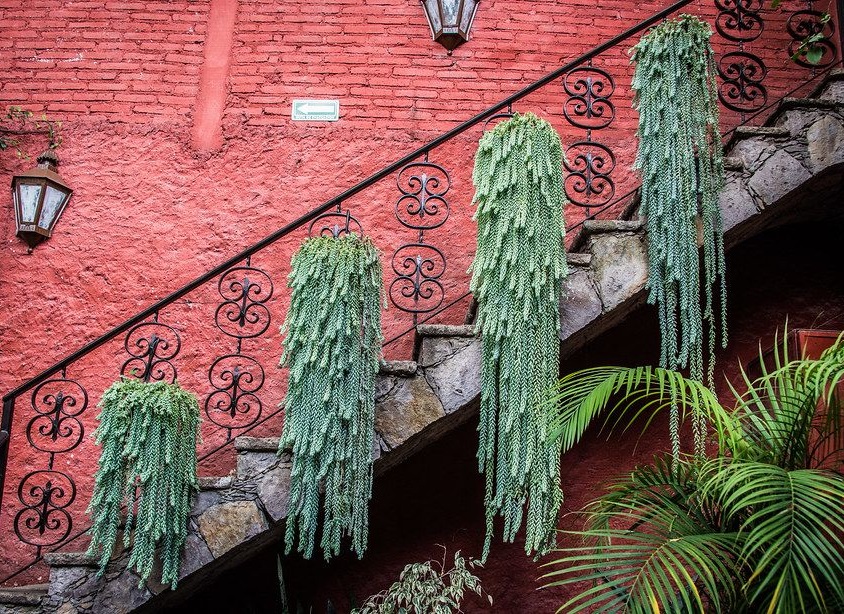
There you have it — my top 12 sensational hanging succulents and hanging cactus that are easy to grow and to source. How many on this list did you already know and grow? I’m hoping not too many of you will score all 12! Please take a moment to drop me a message and let me know! And if you have any questions — bring ’em on! 🙂
Because life is just better with succulents!
P.S. For more succulent information and DIY’s, please subscribe to The Succulent Eclectic! I’ll send you my FREE e-course, 7 Steps to Succulent Success. Thank you!
